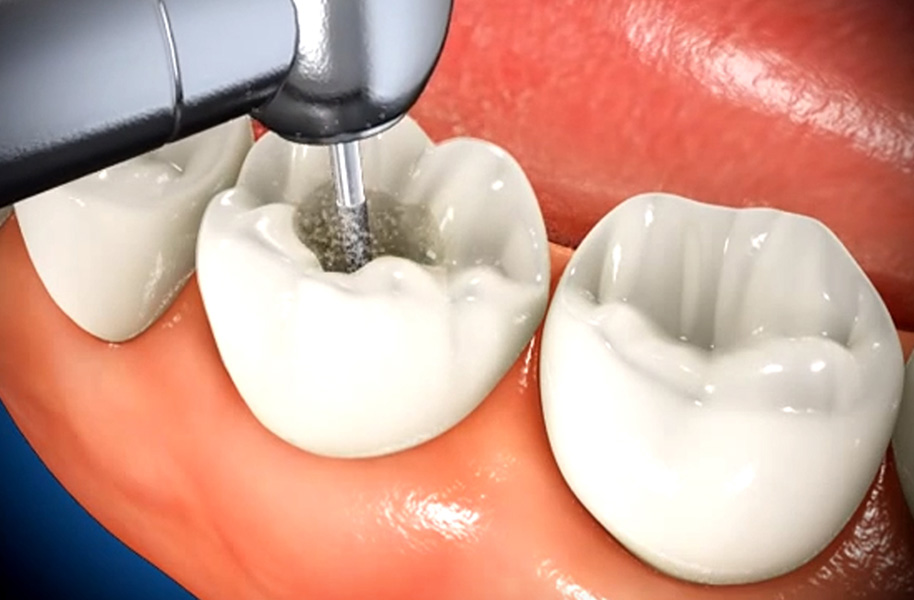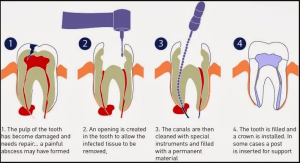If you have a tooth which is hurting a root canal procedure may be the solution. Root canal therapy is the most commonly performed procedure amongst all endodontic (inside tooth) treatment procedures. St. Lawrence Dentistry performs root canal treatment to treat problems related to the soft inner pulp of a tooth. The pulp is the part in the center of a tooth made up of living connective tissue and cells called odontoblasts.
Root canal treatment is required when nerve tissue inside the teeth degenerates. Without root canal treatment, the infection in the tooth pulp can result in an abscess, which in turn can cause damage to the jawbone. You will need a root canal to save your tooth and to ensure that the tissue around the root of the tooth remains healthy and free from inflammation.
There are several reasons why your tooth may become irritated and inflamed, such as: deep decay, big fillings, trauma to the tooth, a chipped tooth or even repeated dental work.
You may need a root canal if a tooth is causing you pain or if the gums adjacent to the tooth are tender and swollen. Another symptom is if the tooth appears discolored and has become extra sensitive to heat and cold. If these symptoms reveal inflamed and infected pulp inside the tooth then your dentist may recommend a root canal procedure.
Dental caries(cavities), chipped teeth, cracked dental fillings, and injury to the teeth can cause damage to the dental pulp. If dental caries are not treated in time, the decay can spread inward into the tooth pulp causing nerve damage. Cracked dental fillings allow saliva and harmful bacteria to reach the root canal and infect the pulp. Fractured teeth can expose the pulp. Injury to the teeth can cause pulp damage even if there are no external signs of damage to the inside of the teeth.
When the nerves inside the tooth pulp die, the tooth dentin and enamel can no longer receive organic nutrients and moisture. The inflamed tissue surrounding the tooth causes toothache and infection can damage the bones around the teeth. If the damaged pulp is not treated, bacterial infection and inflammation can loosen the tooth and it may have to be removed. Therefore, root canal therapy is necessary to preserve the tooth and also protect the jawbone.
At St. Lawrence Dentistry all root canal procedures are performed with the aid of the Global Dental microscope to ensure the highest levels of accuracy. The procedure takes place in four steps. First, Dr. Hawryluk will study the x-ray of the infected tooth and then will administer local anesthetic. Then, the dentist removes the inflamed nerve tissue through an opening in the crown of the tooth. The root canal is cleaned properly so that no debris or bacteria is left behind. This will ensure that infection and tissue swelling does not happen again. In the second step, the dentist will seal off the cleaned root canal cavity. This is to prevent fluids and bacteria from entering the cavity. In the third step the root canal is filled with gutta-percha and adhesive cement mixture. In the fourth and final step, a crown is placed on the sealed tooth which allows the tooth to function normally.
After completion of root canal therapy you might feel some discomfort for few days following the treatment. To alleviate the discomfort you can follow the dentist’s recommendation on taking an over the counter pain medication. In some cases the dentist may prescribe an antibiotic and prescription-strength pain reliever to help reduce any remaining infection.
Following root canal therapy you should never chew directly on the repaired tooth until its final restoration has occurred or your tooth may crack. Also, keep in mind that the longer you wait to complete the final restoration the more likely bacteria will re-infect the treated canal requiring the therapy to be performed all over.
To learn more about what to expect during a root canal please visit our article:
What to expect during a Root Canal
To learn more about root canal retreatment please visit our article:
Re-treatment of a Missed Canal
A “root end” procedure is sometimes done in conjunction with a root canal. Please visit out article on this subject:
Root End Procedures Can Save Teeth
- St. Lawrence Dentistry Looks Forward To St. Patrick’s Day! - March 12, 2025
- Understanding Dental X-Rays and Radiation: What You Should Know - January 13, 2025
- Happy New Year from St. Lawrence Dentistry! - December 30, 2024














